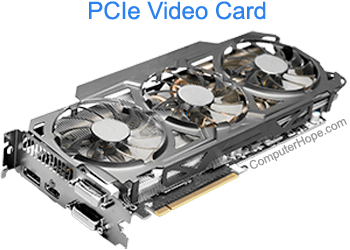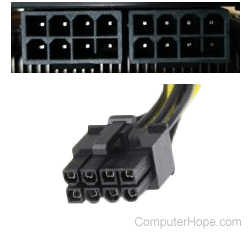How to install a computer video card

To properly install a video card (GPU) in your computer, follow these recommended steps and precautions.
Buying tips and help
The steps on this page assume you have a new or used video card that you want to install.
To upgrade your video card but are unsure which card to buy, see: Computer video card buying tips.
Many modern computers include onboard graphics, making a discrete video card unnecessary. However, discrete video cards offer higher performance, which may be desirable for gaming, 3D modeling, or video editing applications.
Before getting started
Before performing the installation, run through the following checklist.
- Write down important information from the top or bottom of the card, such as the Model Number, Serial Number, and specifications.
- Ensure you are familiar with ESD (electrostatic discharge) and its potential dangers.
- When physically installing the video card, ensure the computer is powered down and unplugged.
- Finally, verify that the computer's motherboard has an available PCI Express, AGP (accelerated graphics port), or PCI slot for the video card. If you are planning on taking out your previous video card to install the new video card, ensure the slot is compatible with your new video card. Some older computer cases have a proprietary AGP slot, causing only certain video cards to be compatible with the computer.
Legacy video cards feature jumpers for proper configuration. If you're installing an older video card, verify that the jumpers are correctly set to the correct IRQ (interrupt request) resource settings.
Remove existing video card
If you are installing a new video card to replace a bad or old one in the computer, you must remove the existing one first. To remove the video card, you may need to push down on a small plastic clip on the right side of the expansion slot. The plastic clip helps keep the video card in place, and pushing down on it "unlocks" it, allowing you to gently but firmly pull the video card out of the expansion slot.
The plastic clip is part of the expansion slot, not the video card. When pressing down, you should be moving the tab towards the motherboard.
Install into the expansion slot
Today, nearly all video cards install into a PCIe (PCI Express) expansion slot. Older video cards are connected to a PCI or AGP expansion slot. Locate an available slot in the computer and gently push the card into the slot until it snaps into place. Once inserted, place a screw into the top of the card to secure the card into position.
Connect a power cable

Some higher-performance video cards require additional power to function properly. These video cards have a single or dual power connection, with each connection having 6 pins or 8 pins. The power connection is on the top-right edge of the card.
If the video card has a power connection, connect a power cable to the video card by inserting the power cable connector into the video card connection.
Connect the computer monitor
After installing the video card and connecting a power cable, connect the monitor's DVI (digital visual interface), HDMI (High-Definition Multimedia Interface), or DisplayPort cable to the new video card from the back of the computer.
To connect the monitor to a video card DisplayPort, you may need a DVI-to-DisplayPort or HDMI-to-DisplayPort adapter, as many monitors only have DVI or HDMI.
BIOS or CMOS setup
Once the video card is installed, place the case back onto the computer and connect the power cable to the computer.
If your computer has an onboard video card, determine if the video card can be disabled through the CMOS setup.
Software setup
After the card is installed, your video card should have come with software drivers for your operating system on a CD (compact disc). Install these drivers and any needed software for the video card.
If the video card did not include drivers or the drivers appear not to work, download the latest video card drivers from the video card manufacturer's website.
Troubleshooting
If you follow the above steps but the video card isn't working, review our support pages for steps that might help fix the problem.
